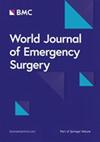Clinical outcome analysis for surgical fixation versus conservative treatment on rib fractures: a systematic evaluation and meta-analysis
IF 5.8
1区 医学
Q1 EMERGENCY MEDICINE
引用次数: 0
Abstract
The efficacy of surgical intervention for traumatic rib fractures in improving clinical outcomes remains a subject of considerable debate. Over the past decade, the adoption of surgical stabilization for rib fractures (SSRF) has increased substantially. This study presents a systematic review and meta-analysis of the literature published over the past 20 years, with the objective of comparing the clinical outcomes of adult patients with multiple traumatic rib fractures who underwent SSRF, relative to those treated conservatively. We searched six online databases (PubMed, Web of Science, Embase, Cochrane Library, and the Sino-American Clinical Trials Database) for literature published between June 2004 and June 2024. The Cochrane Collaboration Risk of Bias 2 (RoB 2) and the Newcastle–Ottawa Scale (NOS) tool were employed to assess methodological quality, and relative risks (RR) with 95% confidence intervals (CI) were calculated to evaluate the outcome measures. The primary outcome was all-cause mortality, while the secondary outcomes included hospital length of stay (HLOS), ICU length of stay (ILOS), duration of mechanical ventilation (DMV), and the incidence of pneumonia. Subgroup analyses were performed to assess the effects of fracture type, age, timing of surgical fixation, and study design on treatment outcomes. A total of 47 studies involving 1,078,795 patients were included, consisting of three randomized controlled trials and 44 case–control studies. The results demonstrated that patients who underwent SSRF experienced better outcomes than those receiving conservative treatment in terms of all-cause mortality. However, SSRF was not superior to conservative treatment regarding HLOS, ILOS, or health care costs. Subgroup analyses revealed that the SSRF group had a lower incidence of pneumonia and shorter DMV in patients with flail chest, and patients older than 60 years may also benefit from SSRF, Furthermore, those who underwent SSRF within 72 h had shorter HLOS and DMV compared to those treated conservatively. SSRF reduces mortality in patients with multiple rib fractures compared to conservative management, particularly in those with flail chest and in patients over 60 years of age. It also offers benefits in terms of pneumonia incidence and DMV for patients with flail chest. Early SSRF may significantly reduce HLOS and DMV. However, careful screening of appropriate candidates is crucial to maximize the benefits of SSRF.肋骨骨折手术固定与保守治疗的临床结果分析:系统评价和荟萃分析
外伤性肋骨骨折的手术干预在改善临床结果方面的有效性仍然是一个相当有争议的话题。在过去的十年中,采用手术稳定治疗肋骨骨折(SSRF)已经大大增加。本研究对过去20年发表的文献进行了系统回顾和荟萃分析,目的是比较多发外伤性肋骨骨折成人患者接受SSRF治疗与保守治疗的临床结果。我们检索了6个在线数据库(PubMed、Web of Science、Embase、Cochrane Library和中美临床试验数据库),检索了2004年6月至2024年6月间发表的文献。采用Cochrane Collaboration Risk of Bias 2 (RoB 2)和Newcastle-Ottawa Scale (NOS)工具评估方法学质量,计算具有95%置信区间(CI)的相对风险(RR)来评估结果测量。主要结局为全因死亡率,次要结局包括住院时间(HLOS)、ICU住院时间(ILOS)、机械通气时间(DMV)和肺炎发生率。进行亚组分析以评估骨折类型、年龄、手术固定时间和研究设计对治疗结果的影响。共纳入47项研究,涉及1,078,795例患者,包括3项随机对照试验和44项病例对照研究。结果表明,在全因死亡率方面,接受SSRF治疗的患者比接受保守治疗的患者有更好的结果。然而,在HLOS、ILOS或医疗费用方面,SSRF并不优于保守治疗。亚组分析显示,SSRF组连枷胸患者的肺炎发生率较低,DMV较短,年龄大于60岁的患者也可能受益于SSRF。此外,与保守治疗的患者相比,在72小时内接受SSRF治疗的患者HLOS和DMV较短。与保守治疗相比,SSRF降低了多发肋骨骨折患者的死亡率,尤其是连枷胸患者和60岁以上患者。它还为连枷胸患者提供肺炎发病率和DMV方面的益处。早期SSRF可显著降低HLOS和DMV。然而,仔细筛选合适的候选人对于最大化SSRF的益处至关重要。
本文章由计算机程序翻译,如有差异,请以英文原文为准。
求助全文
约1分钟内获得全文
求助全文
来源期刊

World Journal of Emergency Surgery
EMERGENCY MEDICINE-SURGERY
CiteScore
14.50
自引率
5.00%
发文量
60
审稿时长
10 weeks
期刊介绍:
The World Journal of Emergency Surgery is an open access, peer-reviewed journal covering all facets of clinical and basic research in traumatic and non-traumatic emergency surgery and related fields. Topics include emergency surgery, acute care surgery, trauma surgery, intensive care, trauma management, and resuscitation, among others.
 求助内容:
求助内容: 应助结果提醒方式:
应助结果提醒方式:


